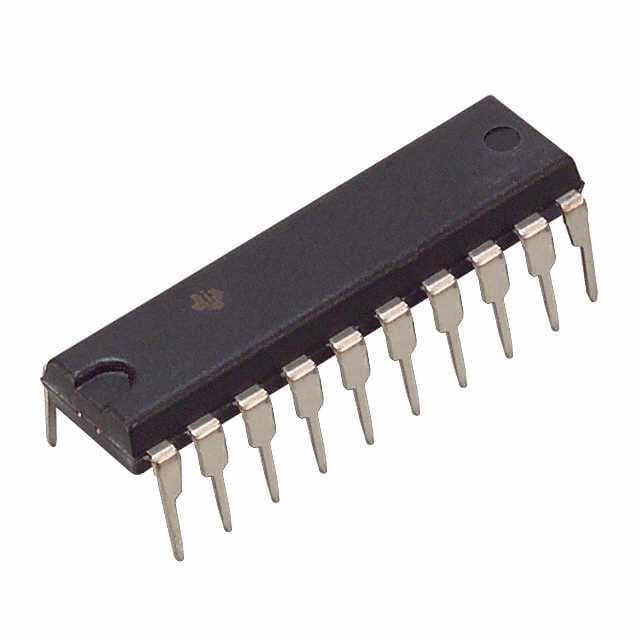Consulte las especificaciones para obtener detalles del producto.

SN74S241N
Product Overview
- Category: Integrated Circuit (IC)
- Use: Logic Gate
- Characteristics: High-speed, TTL compatible, 3-state outputs
- Package: DIP (Dual In-line Package)
- Essence: Octal buffer/line driver with 3-state outputs
- Packaging/Quantity: Available in tubes or reels, quantity varies based on supplier
Specifications
- Supply Voltage: 4.75V to 5.25V
- Input Voltage: 0V to VCC
- Output Voltage: 0V to VCC
- Operating Temperature Range: -40°C to +85°C
- Propagation Delay Time: 9ns (typical)
- Output Current: ±24mA
- Input Capacitance: 10pF
- Output Capacitance: 15pF
Detailed Pin Configuration
The SN74S241N has a total of 20 pins, which are assigned as follows:
- GND (Ground)
- A1 (Input A1)
- B1 (Input B1)
- Y1 (Output Y1)
- A2 (Input A2)
- B2 (Input B2)
- Y2 (Output Y2)
- A3 (Input A3)
- B3 (Input B3)
- Y3 (Output Y3)
- A4 (Input A4)
- B4 (Input B4)
- Y4 (Output Y4)
- A5 (Input A5)
- B5 (Input B5)
- Y5 (Output Y5)
- A6 (Input A6)
- B6 (Input B6)
- Y6 (Output Y6)
- VCC (Positive Power Supply)
Functional Features
The SN74S241N is an octal buffer/line driver with 3-state outputs. It is designed to provide high-speed, TTL compatible buffering and line driving capabilities. The 3-state outputs allow multiple devices to be connected to a common bus, enabling efficient data transfer.
Advantages and Disadvantages
Advantages: - High-speed operation - TTL compatibility - 3-state outputs for bus sharing
Disadvantages: - Limited voltage range (4.75V to 5.25V) - Relatively low output current (±24mA)
Working Principles
The SN74S241N operates by receiving input signals on its A1-A6 and B1-B6 pins. These inputs are then buffered and amplified internally. The resulting output signals are available on the Y1-Y6 pins. The 3-state outputs can be enabled or disabled using control signals, allowing the device to be effectively disconnected from the bus when not in use.
Detailed Application Field Plans
The SN74S241N is commonly used in various applications, including:
- Data communication systems
- Memory address decoding
- Bus interface circuits
- Control systems
- Industrial automation
Detailed and Complete Alternative Models
Some alternative models that offer similar functionality to the SN74S241N include:
- SN74LS241N
- SN74HC241N
- SN74HCT241N
- SN74ALS241N
- SN74F241N
These alternatives may have slight variations in specifications and characteristics, but they serve the same purpose of providing octal buffer/line driver functionality with 3-state outputs.
Word count: 346 words
Enumere 10 preguntas y respuestas comunes relacionadas con la aplicación de SN74S241N en soluciones técnicas
Sure! Here are 10 common questions and answers related to the application of SN74S241N in technical solutions:
Question: What is SN74S241N?
- Answer: SN74S241N is a specific type of integrated circuit (IC) commonly used in digital logic applications.Question: What is the function of SN74S241N?
- Answer: SN74S241N is a 3-state octal buffer/line driver IC, which means it can control the flow of data between multiple devices.Question: What voltage levels does SN74S241N support?
- Answer: SN74S241N supports a wide range of voltage levels, typically from 2V to 6V.Question: How many input/output pins does SN74S241N have?
- Answer: SN74S241N has a total of 20 pins, with 8 input pins and 8 output pins.Question: Can SN74S241N be used for bidirectional communication?
- Answer: No, SN74S241N is not designed for bidirectional communication. It is primarily used for unidirectional data transfer.Question: What is the maximum current that SN74S241N can handle?
- Answer: SN74S241N can handle a maximum current of around 25mA per output pin.Question: Is SN74S241N compatible with TTL logic levels?
- Answer: Yes, SN74S241N is compatible with TTL (Transistor-Transistor Logic) logic levels, making it suitable for interfacing with other TTL-compatible devices.Question: Can SN74S241N be cascaded to increase the number of outputs?
- Answer: Yes, SN74S241N can be cascaded to increase the number of outputs by connecting the output of one IC to the input of another.Question: What is the typical operating frequency range of SN74S241N?
- Answer: SN74S241N can operate at frequencies up to several megahertz (MHz), depending on the specific application and conditions.Question: Are there any special considerations when using SN74S241N in high-speed applications?
- Answer: Yes, in high-speed applications, it is important to consider factors such as signal integrity, transmission line effects, and proper decoupling to ensure reliable operation.
Please note that these answers are general and may vary based on specific application requirements and datasheet specifications.

